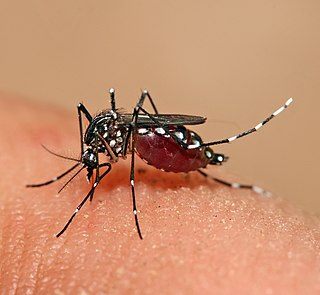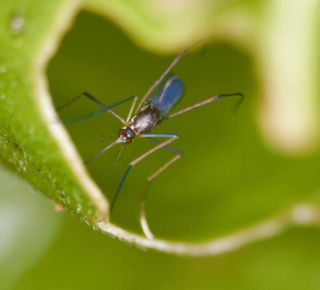
Aedes is a genus of mosquitoes originally found in tropical and subtropical zones, but now found on all continents except Antarctica. Some species have been spread by human activity: Aedes albopictus, a particularly invasive species, was spread to the Americas, including the United States, in the 1980s, by the used-tire trade.

Toxorhynchites, also called elephant mosquito or mosquito eater, is a genus of diurnal and often relatively colorful mosquitoes, found worldwide between about 35° north and 35° south. Most species occur in forests. It includes the largest known species of mosquito, at up to 18 mm (0.71 in) in length and 24 mm (0.94 in) in wingspan. It is among the many kinds of mosquito that do not consume blood. The adults subsist on carbohydrate-rich materials, such as honeydew, or saps and juices from damaged plants, refuse, fruit, and nectar.
Stegomyia is a large subgenus of the mosquito genus Aedes with 131 species classified in six species groups, two groups of which are further divided into subgroups.

Ixodes is a genus of hard-bodied ticks. It includes important disease vectors of animals and humans, and some species inject toxins that can cause paralysis. Some ticks in this genus may transmit the pathogenic bacterium Borrelia burgdorferi responsible for causing Lyme disease. Additional organisms that may be transmitted by Ixodes are parasites from the genus Babesia, which cause babesiosis, and bacteria from the related genus Anaplasma, which cause anaplasmosis.
Ochlerotatus is a genus of mosquito. Until 2000, it was ranked as a subgenus of Aedes, but after Reinert's work, the clade was upgraded to the level of a genus. This change has resulted in the renaming of many subgenus species, and many aedini-related taxa are undergoing taxonomic revisions. Some authors are still using traditional taxonomic names in their publications.

Anopheles is a genus of mosquitoes (Culicidae) with about 484 recognised species.
Pseudoficalbia is a subgenus of the mosquito genus Uranotaenia with 146 species. It was originally created as a genus by Frederick Vincent Theobald in 1911 ; however, it was later treated as a subgenus of Uranotaenia, and then was made a synonym of the same genus. It was later restored as a subgenus by E.L. Peyton in 1972.
Uranotaenia is a subgenus of the mosquito genus Uranotaenia with 121 species:

Coquillettidia is a mosquito genus erected by entomologist Harrison Gray Dyar Jr. in 1904 based primarily on unique features of its "peculiar" male genitalia. The specific epithet honors Dyar's colleague Daniel William Coquillett.
The Afrotropical mosquito genus Eretmapodites contains species that exhibit facultative cannibalism in their larval developmental stages. The species was first described in 1901 by Frederick Vincent Theobald. The type species is Eretmapodites quinquevittatus Theobald
Lutzia is a genus of mosquitos. First described in 1903 by Frederick Vincent Theobald, it includes species whose larval stages exhibit predatory behavior. The type species is Lutzia bigoti.
Mimomyia (Mimomyia) luzonensis is a species of zoophilic mosquito belonging to the genus Mimomyia. It is found in Sri Lanka Bangladesh, Cambodia, China, Hong Kong, India, Indonesia, Japan, Malaysia, Myanmar, Nepal, Pakistan, Philippines, Singapore, Taiwan, Thailand, and Vietnam.

Wyeomyia is a genus of mosquitoes first described in 1901 by Frederick Vincent Theobald. The genus's 140 species can be difficult to characterize because of their diversity and the need for additional taxonomic work to further delineate them. Adults resemble genus Limatus and Sabethes mosquitoes more closely than other genera in the New World tribe Sabethini, but differ by their scutal scales ranging in color from a relatively dull bronzy with a slight metallic sheen in most species, to a metallic gold. There are other distinguishing characters as well.

Armigeres is a genus of mosquito belonging to the family Culicidae. Certain species of Armigeres have the ability to raise their hindlegs and create an egg raft, in which they transport eggs and carefully deposit those eggs onto the water's surface.
Tripteroides is a genus of mosquitoes belonging to the family Culicidae. It is a large and complex assemblage of 122 species and 5 subgenera. Species are distributed from India to Japan, and south to Australia including the islands of southeast Asia and the South Pacific. The species comprising the genus are highly diverse, and the relationships among Tripteroides and Trichoproposon species remain unresolved as many characters overlap. The taxonomic status of this genus urgently needs revision to better understand the relationships among the species and to improve the classification of the genus.







